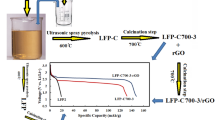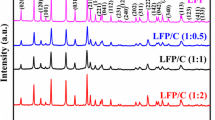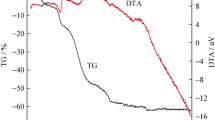Abstract
Binary carbon mixtures, carbon black ECP 600JD (ECP) combined with vapor grown carbon fiber (VGCF) or carbon nanotube (CNT), or graphene (Gr) in different mass ratios, are investigated as the conductive additives for the cathode material polyoxomolybadate Na3[AlMo6O24H6] (NAM). Field emission scanning electron microscopy and energy dispersive X-ray spectroscopy show that the surfaces of NAM particles are covered homogeneously with the binary conductive additive mixtures except the combination of ECP and CNT. The optimum combination is the mixture of ECP and VGCF, which shows higher discharge capacity than the combinations of ECP and CNT or Gr. Initial discharge capacities of 364, 339, and 291 mA·h/g are obtained by the combination of ECP and VGCF in the mass ratios of 2:1, 1:1, and 1:2, respectively. The results of electrochemical impedance spectra and 4-pin probe measurements demonstrate that the combination of ECP and VGCF exhibits the highest electrical conductivity for the electrode.
Similar content being viewed by others
References
LINDEN D, REDDY T B. Handbook of batteries: Third edition [M]. New York: McGraw-Hill, 2001.
AIFANTIS K E, HACKNEY S A, KUMAR R V. High energy density lithium batteries: Materials, engineering, applications [M]. Germany: Wiley-VCH, 2010.
ABRAHAM K M, SCHALKWIJK W A V, HASSOUN J. Lithium batteries: Advanced technologies and applications [M]. New Jersey: John Wiley & Sons, Inc, 2013.
AURBACH D. Review of selected electrode–solution interactions which determine the performance of Li and Li ion batteries [J]. J Power Sources, 2000, 89: 206–218.
TARASCON J M, ARMAND M. Review article Issues and challenges facing rechargeable lithium batteries [J]. Nature, 2001, 414: 359–367.
WHITTINGHAM M S. Lithium batteries and cathode materials [J]. Chem Rev, 2004, 104: 4271–4301.
CABANA J, MONCONDUIT L, LARCHER D, PALACÍN M R. Beyond intercalation-based Li-Ion batteries: the state of the art and challenges of electrode materials reacting through conversion reactions [J]. Adv Mater, 2010, 22: E170–E192.
ELLIS B L, LEE K T, NAZAR L F. Positive electrode materials for Li-ion and Li-batteries [J]. Chem Mater, 2010, 22: 691–714.
GOODENOUGH J B, KIM Y. Challenges for rechargeable Li batteries [J]. Chem Mater, 2010, 22: 587–603.
XU B, QIAN D N, WANG Z Y, MENG S Y. Recent progress in cathode materials research for advanced lithium ion batteries [J]. Mater Sci Eng, 2012, R73: 51–65.
GOODENOUGH J B, PARK K S. The Li-ion rechargeable battery: A perspective [J]. J Am Chem Soc, 2013, 135: 1167–1176.
MELOT B C, TARASCON J M. Design and preparation of materials for advanced electrochemical storage [J]. Acc Chem Res, 2013, 46: 1226–1238.
MIZUSHIMA K, JONES P C, WISEMAN P J, GOODENOUGH J B. LixCoO2 (0<x<1): A new cathode material for batteries of high energy density [J]. Mater Res Bull, 1980, 15: 783–789.
REIMERS J N, DAHN J R. Electrochemical and in situ X-ray diffraction studies of lithium intercalation in LixCoO2 [J]. J Electrochem Soc, 1992, 139: 2091–2097.
OHZUKU T, UEDA A. Solid-state redox reactions of LiCoO2(R3m) for 4 volt secondary lithium cells [J]. J Electrochem Soc, 1994, 141: 2972–2977.
LEVI M D, SALITRA G, MARKOVSKY B, TELLER H, AURBACH D, HEIDER U, HEIDERB L. Solid-state electrochemical kinetics of Li-ion intercalation into Li1-xCoO2: Simultaneous application of electroanalytical techniques SSCV, PITT, and EIS [J]. J Electrochem Soc, 1999, 164(4): 1279–1289.
OHZUKU T, MAKIMURA Y. Layered lithium insertion material of LiNi1/2Mn1/2O2: A possible alternative to LiCoO2 for advanced lithium-ion batteries [J]. Chem Lett, 2001, 30(8): 744–745.
OHZUKU T, MAKIMURA Y. Layered lithium insertion material of LiCo1/3Ni1/3Mn1/3O2 for lithium-ion batteries [J]. Chem Lett, 2001, 30(7): 642–643.
LU Z H, BEAULIEU L Y, DONABERGER R A, THOMAS C L, DAHN J R. Synthesis, structure, and electrochemical behavior of Li[NixLi1/3-2x/3Mn2/3-x/3]O2 [J]. J Electrochem Soc, 2002, 149(6): A778–A791.
CHO J, KIM H, PARK B. Comparison of overcharge behavior of AlPO4-coated LiCoO2 and LiNi0.8Co0.1Mn0.1O2 cathode materials in Li-ion cells [J]. J Electrochem Soc, 2004, 151(10): A1707–1711.
MENG X L, DOU S M, WANG W L. High power and high capacity cathode material LiNi0.5Mn0.5O2 for advanced lithium-ion batteries [J]. J Power Sources, 2008, 184(2): 489–493.
LI Z, DU F, BIE X, ZHANG D, CAI Y, CUI X, WANG C. Electrochemical kinetics of the Li[Li0.23Co0.3Mn0.47]O2 cathode material studied by GITT and EIS [J]. J Phys Chem C, 2010, 114: 22751–22757.
TARASCON J M, GUYOMARD D. The Li1+xMn2O4/C rockingchair system: A review [J]. Electrochimica Acta, 1993, 39(9): 1221–1231.
GUMMOW R J, KOCK A D, THACKERAY M M. Improved capacity retention in rechargeable 4 V lithium/lithium-manganese oxide (spinel) cells [J]. Solid State Ionics, 1994, 69(1): 59–67.
JANG D H, SHIN Y J, OH S M. Dissolution of spinel oxides and capacity losses in 4 V Li/LixMn2O4 cells [J]. J Electrochem Soc, 1996, 143: 2204–2211.
XIA Y Y, ZHOU Y H, YOSHIO M. Capacity fading on cycling of 4 V Li/LiMn2O4 cells [J]. J Electrochem Soc, 1997, 144(8): 2593–2600.
THACKERAY M M, SHAO-HORN Y, KAHAIAN A J, KEPLER K D, SKINNER E, VAUGHEY J T, HACKNEY S A. Structural fatigue in spinel electrodes in high voltage (4 V) Li/LixMn2O4 cells [J]. Electrochem Solid-State Lett, 1998, 1: 7–9.
PADHI A K. Phospho-olivines as positive-electrode materials for rechargeable lithium batteries [J]. J Electrochem Soc, 1997, 144(4): 1188–1194.
PADHI A K, NANJUNDASWAMY K S, MASQUELIER C, OKADA S, GOODENOUGH J B. Effect of structure on the Fe3+/Fe2+ redox couple in iron phosphates [J]. J Electrochem Soc, 1997, 144(5): 1609–1613.
HUANG H, YIN S C, NAZAR L F. Approaching theoretical capacity of LiFePO4 at room temperature at high rates [J]. Electrochem Solid-State Lett, 2001, 4(10): A170–A172.
DELACOURT C, POIZOT P, TARASCON J M, MASQUELIER C. The existence of a temperature-driven solid solution in LixFePO4 for 0<x<1 [J]. Nature Mater, 2005, 4: 254–260.
SONG M K, ZHANG Y G, CAIRNS E J. A long-life, high-rate lithium/sulfur cell: A multifaceted approach to enhancing cell performance [J]. Nano Lett, 2013, 13: 5891–5899.
SONOYAMA N, SUGANUMA Y, KUME T, QUAN Z. Lithium intercalation reaction into the Keggin type polyoxomolybdates [J]. J Power Sources, 2011, 196(16): 6822–6827.
UEMATSU S, QUAN Z, SUGANUMA Y, SONOYAMA N. Reversible lithium charge–discharge property of bi-capped Keggintype polyoxovanadates [J]. J Power Sources, 2012, 217: 13–20.
NI E F, UEMATSU S, QUAN Z, SONOYAMA N. Improved electrochemical property of nanoparticle polyoxovanadate K7NiV13O38 as cathode material for lithium battery [J]. J Nanopart Res, 2013, 15: 1732–1741.
CHEN W, HUANG L J, HU J, LI T F, JIA F F, SONG Y F. Connecting carbon nanotubes to polyoxometalate clusters for engineering high-performance anode materials [J]. Phys Chem Chem Phys, 2014, 16: 19668–19673.
KUME K, KAWASAKI N, WANG H, YAMADA T, YOSHIKAWA H, AWAGA K. Enhanced capacitor effects in polyoxometalate/graphene nanohybrid materials: A synergetic approach to high performance energy storage [J]. J Mater Chem A, 2014, 2: 3801–3807.
NAUMAAN R, KHAN N, MAHMOOD N, LV C, SIMA G, ZHANG J, HAO J, HOU Y, WEI Y. Pristine organo-imido polyoxometalates as an anode for lithium ion batteries [J]. RSC Adv, 2014, 4: 7374–7379.
NI E F, KUME T, UEMATSU S, QUAN Z, SONOYAMA N. Effect of annealing treatment on the electrochemical properties of polyoxomolybdate K4[SiMo12O40] as cathode material of lithium battery [J]. Electrochemistry, 2014, 82: 14–18.
NI E F, UEMATSU S, SONOYAMA N. Anderson type polyoxomolybdate as cathode material of lithium ion battery and its reaction mechanism [J]. J Power Sources, 2014, 267: 673–681.
NI E F, UEMATSU S, SONOYAMA N. Lithium intercalation into the polyoxovanadate K7MnV13O38 as cathode material of lithium ion battery [J]. Solid State Ionics, 2014, 268: 222–225.
WANG H, YAMADA T, HAMANAKA S, YOSHIKAWA H, AWAGA K. Cathode composition dependence of battery performance of polyoxometalate (POM) molecular cluster batteries [J]. Chem Lett, 2014, 43: 1067–1069.
NI E F, UEMATSU S, TSUKADA T, SONOYAMA N. Lithium intercalation into polyoxomolybdate (NH4)6[NiMo9O32] as the cathode material of lithium battery [J]. Solid State Ionics, 2016, 285: 83–90.
Author information
Authors and Affiliations
Corresponding author
Rights and permissions
About this article
Cite this article
Li, Wl., Ni, Ef., Li, Xh. et al. Effect of binary conductive additive mixtures on electrochemical performance of polyoxomolybdate as cathode material of lithium ion battery. J. Cent. South Univ. 23, 2506–2512 (2016). https://doi.org/10.1007/s11771-016-3310-y
Received:
Accepted:
Published:
Issue Date:
DOI: https://doi.org/10.1007/s11771-016-3310-y




